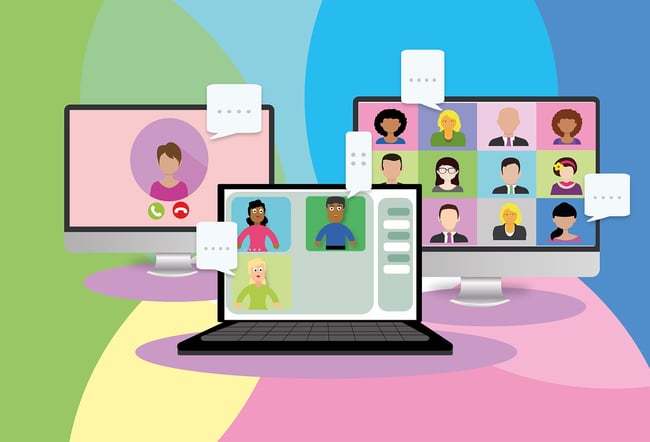Designing an Automated Webinar for Internal Communications
Most people use webinars to communicate with external audiences like prospects and customers. However, webinars can also be influential in communication success inside a company.
Webinars offer a practical way to present internal communications. But you must be mindful of how live and automated webinars differ and learn how to connect with an internal audience versus an external one. Automated webinars are ideal for internal communications. Employees can watch the content at their convenience, making this a valuable resource for any company.
Particularly, large organizations that are hybrid or fully remote are then able to provide interactive content to all employees, regardless of time zone. With only 19% of companies remaining fully on-site in 2022, strategies to improve the employee experience must change. Repetitive information sessions can be time-consuming to host over and over again, such as those used in onboarding and training new employees. Automated webinars that have interactive features save you time while maintaining the personalized attention that employees require to thrive. Incorporating webinar software that allows you to have live and asynchronous interactions with your workforce is an invaluable asset to your team.
Research, Brainstorm, and Plan Automated Webinar Content
Researching, brainstorming, and planning must be priorities for your pre-recorded webinar to have an impact. Start with the kind of internal communications you want to include in your webinar. For example, on-demand webinars are one of the best tools for onboarding and training remote employees. You can get employees excited about your company and acquainted with their roles and responsibilities.
Remember, the webinar can be evergreen. Employees can always access it if they want to review it later, ask any questions, or use it as an onboarding tool.
Think about what you want to get from your webinars, as well. For example, webinars can be a business intelligence tool. These tools pull worthwhile insights from data that company leaders can use to make more informed decisions. Automated webinars can give you a look into employee engagement and feedback. You can gauge how often employees interact with and finish the webinars.
You may also disseminate an internal satisfaction survey after each webinar to improve the content for next time. Webinars can be a huge data source, especially with interactive polls, questions, and surveys. Leaders can pull insights from this data to make better decisions about improving internal communications for the sake of the productivity and engagement of their team.
Once you know what you will use webinars for and what you want to get out of them, brainstorm topics, map out the structure of your webinars, outline scripts, and assign responsibilities to your team. Use webinar templates so you don’t have to always start from scratch.
Also, decide on the right automated webinar tool to use. Most webinar tools are centered around live webinars, with automated webinar features being somewhat of an afterthought. So, a webinar tool that’s 100% focused on automated webinars is best.
Create and Edit Your Webinar Content 
The great thing about an automated webinar is that you can edit your webinar content and ensure it’s exactly how you want it to be before it goes live.
Figure out how many days it will take for you to record the video content for your webinar and create accompanying visuals for it. Then, block those days off your calendar and ensure the team members involved do the same.
Set up your equipment when the filming day arrives, rally your on-camera talent, and have fun. Give yourself a day to recover once filming wraps, and then start the editing process. Ensure video quality, cohesiveness, audio, presentation, and the central message of the webinar are all up to par.
Take Your Webinar Through a Test Run
In school, you wouldn’t take a test without studying beforehand. The same could be said of any piece of work, especially live-to-permanent webinars. This can be done by asking a select few employees and managers to take your webinar through a test run. This way, you can work out the kinks, add what is missing, and get feedback from different departments before automating it.
You can also catch bugs, content that isn’t loading, confusing messages, and so forth with their help. It’s especially helpful to solicit questions from your workforce beforehand, working the answers into the webinar script. Give yourself enough time between the test run and the launch date to fix whatever needs to be fixed and add whatever needs to be added.
Be Intentional About Promoting Your Webinar to Employees
Designing an automated webinar for internal communications is hard work, especially with all of the pre-planning and testing involved to ensure it’s useful for the future. You could require your employees to watch every internal communications webinar, but it’s so much more fulfilling for the creators involved if employees are intrinsically motivated to do so. You want your employees excited about every release — not dreading it.
That’s where intentional promotion comes in. You must put in the effort to promote your webinar to your staff. Hype it up and show them why it’s something to look forward to. Set up a registration page for the live webinar and attach an incentive to it for those that register early. This can be gift cards, company swag, or even the chance to interact and play themed games or ask questions during the live version.
Send email reminders leading up to the launch, and set up automatic emails that include the pre-recorded webinars whenever a new person joins the team. These can be scheduled to disseminate to them at milestones along their onboarding and training journeys. Give employees a glimpse of the webinar by sharing intriguing snippets in these email reminders. You can also send out refresher emails with similar hype techniques to existing employees, adding links to on-demand webinars they can watch and rewatch at their leisure.
Launch Your Webinar
Even if you’ve pumped up your employees for the live version beforehand, this energy can easily be lost without proper organization upon the launch date. If you’ve already set up a specific time and date for your webinar to become initially available, make sure it rolls out without issue. Send a mass email reminding your employees that your webinar is live and let them know how to watch it afterward.
Your staff can then watch the webinar when it’s convenient for them. It’s impossible to improve a live, one-time webinar. However, with pre-recorded, evergreen webinars, you have the opportunity to tweak certain aspects and make them better with time. Look for automated webinar software that allows you to make changes and improvements. These benefits make automated, on-demand webinars the obvious choice. With the right software, you can even see the employees who have not yet watched the webinar and send them a follow-up email to encourage them to do so.
Have a Plan for Interaction
The best way to create the most interesting and engaging webinar is to encourage interaction from your audience. If you’ve planned an informative webinar outline, your employees will naturally have questions, concerns, and comments.
It’s essential to have a plan for fielding your employees’ questions, comments, and concerns once they view your webinar since you won’t be there live.
You could designate a couple of employees to monitor the chat attached to your webinar tool. Choose software that gives your team the flexibility to jump in and respond to questions live when they are able, but also lets them send responses later by email when they are not. You could also include a contact form in your webinar or ask employees to reach out to a specific email address if they need special assistance.
The goal with an automated webinar is to be as responsive as possible to chat messages and questions sent from attendees, so that the experience is as interactive as possible. However you decide to do it, respond to everything promptly and follow up with your employees whenever needed.
Conclusion
Designing an automated webinar for internal communications doesn’t have to be complex. Give yourself time to work through the steps above to ensure the process is as organized and thorough as possible. That way, what you want to communicate to your team comes across meaningfully in every webinar.








